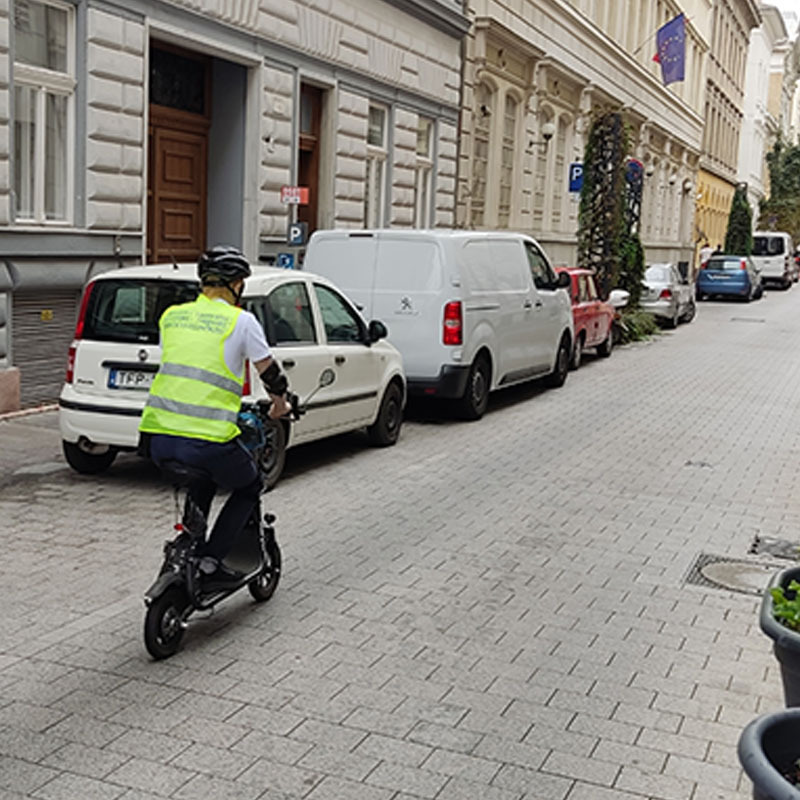In Hungary, a nationwide traffic enforcement system, called VÉDA, was implemented between 2012 and 2015 (first phase), aiming to increase road safety. The VÉDA system consists of mobile and fixed Complex Traffic Control Points that work according to the European Union directive to reduce fatal traffic accidents.
In an average month, the VÉDA system creates 22 million traffic event records, from the outputs of 160 mobile enforcement points and 134 fixed traffic enforcement endpoints.

Mobile Enforcement Solution
The current project contains 160 pieces of Adaptive Recognition® S1 portable speed and traffic enforcement cameras, which can perform onsite
- ANPR (Automatic Number Plate Recognition),
- certified speed measurement, and
- detect a wide range of traffic violations, such as:
- bus- or emergency lane violation,
- forbidden railway or solid line crossing,
- wrong direction or forbidden entry detecting
These cameras work on a tripod but can be placed inside a vehicle, too, and the detection functions keep working even through the windshield. The solution is designed to be completely weather-proof.


Fixed Traffic Control Points
The stationary cross sections (using the Adaptive Recognition TrafficSpot® system) are installed at 134 locations, covering 365 lanes in total, simultaneously gathering data. These fixed enforcement points perform the following functions 24/7:
- ANPR (Automatic Number Plate Recognition)
- ADR (additional license plates of hazardous materials) recognition
- certified speed measurement by radar devices
- red light crossing detection
- bus- or emergency lane surveillance
- forbidden entry detection
- wrong direction detection
- the solid line and forbidden railway crossing detection
- traffic counting and traffic jam detection
- seatbelt usage detection

The Nationwide Layout
Let’s see the numbers. There are 134 fixed locations, 89 in urban environments, and 45 locations at remote roads and highways. The smallest systems cover 2 lanes while the most complex ones monitor 6 lanes in a simultaneous operation.
Product-wise, the fixed control points are managed by Adaptive Recognition TrafficSpot and have
- 365 pieces of Adaptive Recognition® FreewayCAM Full HD cameras with infrared LEDs (for front ANPR)
- 365 pieces of Adaptive Recognition® FreewayCAM HD cameras with infrared LEDs (for rear ANPR)
- 175 pieces of Adaptive Recognition® EnforceCAM (for traffic analytics)
- 200 pieces of categorizing laser scanners
- 365 pieces of certified speed measurement radars

Effects and results
VÉDA is a Hungarian fictive word – based on the verb ‘protect’. This is the most important role of the whole system, to protect and ensure the safety of our society. This aim also appears in the quote Hungarian Police frequently use: ‘so everybody can get home safe’.
We still find it important to emphasize this motivation, as traffic enforcement still comes with mixed feelings in the country (and worldwide) – despite the outstanding results. We at Adaptive Recognition, always consider the bigger picture when developing related technology: to avoid senseless tragedies.
Introducing such a system to a country, and offering nationwide coverage will bring remarkable results independently of location. Only in the first quarter after the launch, Hungary welcomed the following results:
- Deaths in road accidents were reduced by 20%
- Fatal accidents were reduced by nearly 12%
- Severe injuries in road accidents were reduced by almost 10%
In the first year, most of the violation detections were the exceeding of speed limits: resulting in 265,000 recorded events – even though the system was introduced with huge media support.






